Live From World Baseball Classic: MLB Network Concludes Wild Two Weeks With World-Feed Production, Onsite Studio Coverage of Championship in Miami
The broadcaster relied on NEP Japan in Tokyo, NEP’s flypack solutions in Taichung
Story Highlights
If the Major League Baseball regular season is a marathon, the World Baseball Classic (WBC) can rightfully be seen as a sprint. With domestic and international baseball fans glued to their television sets, MLB Network has been tasked with supplying the production and operations foundation for this sprint with a world-feed model for 63 media partners in 144 countries.
“It’s the sheer volume of 47 games in 14 days in three countries on two continents in multiple time zones,” says Jason Hedgcock, senior director, remote technical operations, MLB Network. “There were a lot of double- headers, so we needed to develop a plan that could be executed and replicable.”

Leaders of MLB Network’s production and operations teams onsite in Miami: (from left) Stephanie Perone, Tom Guidice, Susan Stone, Jason Hedgcock, Samantha Calastro, and Chris Pfeiffer
Global Game: Inside the World-Feed Production
Since the launch of the World Baseball Classic in 2006, MLB Network has provided resources to broadcasters looking to showcase the global competition. For this year’s edition, the network has constructed a baseline production of eight unilateral hard cameras: a high-speed unit at 6X, a mid-home robotic camera, POVs for broadcasters to splice into their respective telecasts, and an RF camera for basic angles from a handheld position.
As in years past, broadcasters can supplement and augment their specific coverage with their own cameras. For instance, Fox Sports is adding two cameras — at low third base and low first base — to its arsenal for Tuesday night’s championship bout between the U.S. and Japan. If international broadcasters want to enhance their own dedicated coverage, MLB Network is more than willing to allow that to happen.
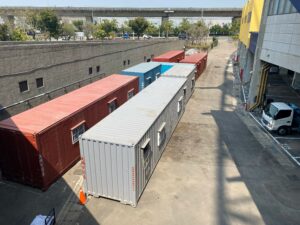
The compound in Taichung comprised shipping containers as makeshift production trailers. (Photo: Samantha Calastro)
“A lot of our international rightsholders that want to come onsite have new technologies, so that requires fewer cameras from us,” says Stephanie Perone, director, remote technology operations, MLB Network. “It comes with an extra amount of communication, but it’s more planning on the frontend.”
For the championship game in Miami, the network’s onsite team of 90 employees is working out of Game Creek Video 79 mobile unit for the world-feed production and is integrating graphics and Statcast from operators at network headquarters in Secaucus, NJ. Besides Fox Sports, MLB Network provides resources for Fox Deportes and Univision and, on the international side, TV Asahi, Tokyo Broadcast Systems, and Amazon Prime Japan, two from Venezuela, and two from Cuba. Operationally, establishing a reliable transmission scheme is essential.
Hedgcock and company are responsible for commentary insertion for broadcasts in 14 languages. Throughout the tournament, English-language commentary has been done by top-notch pairings: Tyler Maun and Ryan Rowland-Smith in Taichung, Taiwan, for Pool A; Stephen Nelson and José Mota in Tokyo for Pool B; Rich Waltz and Buck Martinez in Phoenix for Pool C; and Dave Flemming and Yonder Alonso in Miami for Pool D.
MLB Network’s biggest concern has been serving up feeds and workflows that work for every broadcaster across the board.
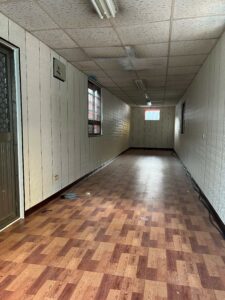
Inside an empty shipping container before gear was installed (Photo: Samantha Calastro)
“We need to keep the technology compatible because we’re transmitting to some countries that have advanced technology on par with or better than the U.S. and some that do not,” Hedgcock says. “We have to produce a product on a technical level compatible with all of these rightsholders so that they can ingest it and broadcast it to their audience.”
In comparison with the 2017 World Baseball Classic, the world-feed model has been perfected since the shortened MLB season in 2020. Largely thanks to the COVID-19 pandemic, MLB Network found itself the main supplier of video feeds for both national and regional sports networks. Nearly three years later, a handful of pandemic-inspired habits have become vital to productions over the past two weeks.
“Some of the things that we learned in the pandemic with multiviewers for remote announcers have been employed here,” adds Hedgcock. “We’ve also become more efficient since 2020, and this event shows how we can partner with multiple broadcasters in a better way.”
From a production perspective, presenting the world feed to various media entities comes with a challenge: shots seen on these unilateral cameras have to remain somewhat neutral. Luckily, the production staff, led by MLB Network VP, Live Events, Chris Pfeiffer, has gained valuable lessons from the pandemic.
“The main priority is to document the game, but we try to add in the international flavor with certain stories,” Pfeiffer says. “Fans can’t get enough of [Japan’s Shohei] Ohtani, so we made sure to have a camera on him to show everything that he does on the field and in the dugout. There has also been so much energy in these venues that we want to capture the atmosphere with shots of the crowd.”
Working Overseas: NEP Japan, Local Staffers Pitch in for International Pools
The magic of the World Baseball Classic is to offer fans in the U.S. and other areas of the globe a peek into unfamiliar baseball venues. In previous years, these have included Hiram Bithorn Stadium in San Juan, Puerto Rico, in 2006; Foro Sol in Mexico City in 2009; Fukuoka Dome in Fukuoka, Japan, in 2013; and Gocheok Sky Dome in Seoul in 2017.
This year, the two international pools took place in Taichung Intercontinental Baseball Stadium in Taiwan and the Tokyo Dome in Tokyo. At the former, MLB Networks Senior Production Manager, Operations, Samantha Calastro was onsite to make sure that any logistical or operational needs ran as smoothly as possible. Game Creek Video housed the team in Phoenix, but Calastro and the team in Taichung produced 10 games via NEP’s flypack solutions from makeshift production trailers made from shipping containers. To save on cost, they relied on local staffers for necessary equipment.
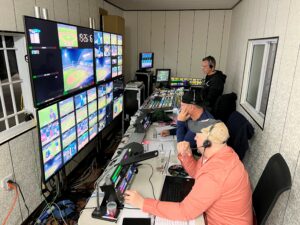
The front bench at work during Italy vs. Netherlands on Sunday, March 12 (Photo: Samantha Calastro)
“We used producer BK Yang, and he ended up sourcing almost everything for us,” says Calastro. “He was able to secure the containers, our crew, and our generator for us.”
In Tokyo, NEP Japan was critical to filling out the production and operations crews. Spearheaded by NEP Japan Technical Manager Tajima Takashi, the companies’ relationship from prior productions made the endeavor as seamless as possible.
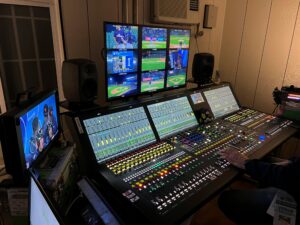
The audio setup in Taichung, Taiwan (Photo: Samantha Calastro)
“He helped us a lot with all of our needs,” says Susan Stone, SVP, operations and engineering, MLB Network. “We also spoke to [NBC Olympics VP, Olympic Operations] Marsha Bird since she has experience working in China. She gave us some great resources and suggestions, which were really helpful.”
Studio Presence in the 305: MLB Tonight Heads to loanDepot Park
Known to create wrap-around coverage of jewel events throughout the MLB calendar, MLB Network has shipped studio talent down to loanDepot Park for the onsite edition of MLB Tonight, with the announce team of host Greg Amsinger, analysts Harold Reynolds and Pedro Martinez, and reporter Jon Morosi dissecting the action. Deploying three cameras — the network’s famous Ballpark Cam, an ENG camera, and the main broadcast camera in centerfield — the program is produced remotely from network headquarters in Secaucus.
In addition, the crew has featured live interviews with stars from different countries during the pre/postgame. Among them have been the United States’ Mike Trout, Mookie Betts, Adam Wainwright, and Cedric Mullins; Japan’s Shohei Ohtani and Lars Nootbar; and Mexico’s Randy Arozarena. MLB Network Coordinating Producer, Field Production, Ben Friedfeld has been important to bringing these guests to the onfield set, located in foul territory next to third base.
“As soon as you step in the clubhouse, it’s business.”@Cardinals outfielder and @samuraijapan_pr star Lars Nootbaar talks about his time with Team Japan and what his experience has been like in the #WorldBaseballClassic.#MLBTonight | @WBCBaseball pic.twitter.com/po89MZcFwK
— MLB Network (@MLBNetwork) March 20, 2023
</center
Not All WBC: MLB Content Forges Ahead During Two-Week Frenzy
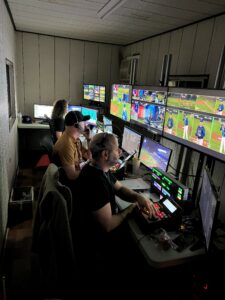
EVS replay operators sit at their positions outside Taichung International Baseball Stadium (Photo: Samantha Calastro)
Although the World Baseball Classic is the center of the baseball world at the moment, MLB Network is covering the upcoming 2023 regular season with its usual fervor. Secaucus is buzzing with its daily programming schedule, and, with the addition of new names to programs like Intentional Talk, there are lots of reasons for fans to flock to MLB Network. The biggest obstacle is continuing its high standard of quality while maintaining the intricate operation of the WBC.
“It’s all about planning,” says Pfeiffer. “The World Baseball Classic has been a priority for a while to make sure we got this in a good place. Once that was ready to go, we began planning for our Showcase games and productions of Friday Night Baseball on Apple TV. Ultimately, we made sure that everyone was organized and prepared before we got started [with the WBC].”
In anticipation of the World Baseball Classic, MLB Network’s Spring Training broadcasts were moved around quite a bit. For example, so that the WBC productions wouldn’t bump up against regular-season Opening Day, the Spring Training broadcasts were moved closer to the beginning of winter. This preemptive move has paid dividends for what the production and operations crew have done since Wednesday, March 8, but, given the fast-paced baseball schedule, the team will hit the ground running after the final out of the championship game.
MLB Network SVP, Production, Marc Caiafa describes the effort ahead: “We had a meeting over the weekend about the Draft; we have more survey visits in two weeks; we have our Apple rehearsals on Wednesday and Thursday of this week; we have our preview shows starting next week. And then it’s Opening Day on Thursday, March 30. The World Baseball Classic is a great, but you can’t take much of a breath afterwards.
Constant Momentum: Hardworking Crew, International Buy-In Put WBC in the Spotlight
More than a month’s worth of games have been squeezed into a condensed schedule. Looking back on the past two weeks, all involved at MLB Network ought to be extremely proud of their efforts.
“Our crew is awesome,” says Caiafa, “but this is easily the most they’ve ever worked. They handled 10 games in five days, which has never been done before in the World Baseball Classic. The fact that they’re smiling and staying upbeat and passionate about this event is pretty cool.”
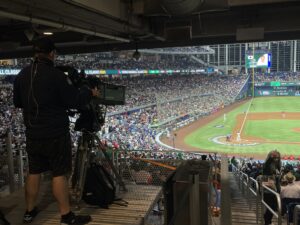
MLB Network handles camera feeds for the world-feed production of the World Baseball Classic.
After Tuesday night, the dust will settle on one of the best World Baseball Classics in the competition’s 17-year history. Storylines were limitless: Trout and Ohtani, Los Angeles Angels’ teammates and two of the best players in the game, going toe-to-toe in the championship game; Mexico, once a potential dark horse, making a run to the semifinals after a comeback win over Puerto Rico; Italy turning heads by defeating the Netherlands to advance to the quarterfinals; and both the Czech Republic and Great Britain snatching their first WBC wins in their debut appearances. After each subsequent edition, the tournament gets better and better after humble beginnings.
“MLB Network didn’t exist in 2006, so we took the ESPN feed and enhanced it with two cameras and a small production truck,” says Tom Guidice, VP, remote operations, MLB Network. “In the past five years, this event has grown tremendously, with the shoulder programming being created, the incredible games being played, and the crowds that have shown up.”
